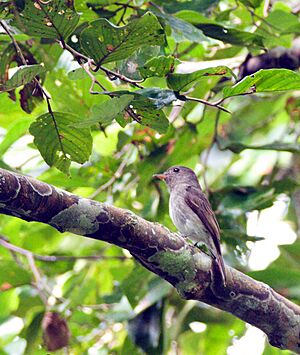Ashy-breasted flycatcher facts for kids
Quick facts for kids Ashy-breasted flycatcher |
|
|---|---|
 |
|
| Conservation status | |
| Scientific classification | |
| Genus: |
Muscicapa
|
| Species: |
randi
|
The ashy-breasted flycatcher (Muscicapa randi) is a small bird that lives only in the Philippines. It is part of the Muscicapidae family, known for catching insects in flight. This special bird is found on just two islands: Negros and Luzon. Its natural home is the warm, wet lowland forests. Unfortunately, it is threatened because its forest home is disappearing.
Contents
What Does the Ashy-Breasted Flycatcher Look Like?
This flycatcher is a small, rather plain-looking bird. It has a gray-brown back and darker wings. Its chest is also gray-brown, which fades into a white belly. You might notice a small white patch on its throat. A key feature is its two-colored beak: the top part is black, and the bottom part is orange.
It looks a bit like another bird called the Furtive Flycatcher. However, the ashy-breasted flycatcher is slightly bigger. It also has an orange lower beak and does not have reddish outer tail feathers. Its tail does not have a black band at the end. Its song is made of very high-pitched, short sounds repeated often.
Where Does the Ashy-Breasted Flycatcher Live?
This bird lives in both old-growth and newer secondary growth forests. It can be found up to 1,000 meters (about 3,300 feet) above sea level. Sometimes, it can even be seen in forest clearings, showing it can handle some changes to its home. It often sits on branches that stick out, usually near the top of the forest trees, called the canopy.
Scientists think these birds might move around within their island homes. This could happen after they have raised their young.
Why Is This Bird in Danger?
The ashy-breasted flycatcher is considered a vulnerable species. This means it is at high risk of becoming endangered. There are likely only between 6,000 and 15,000 of these birds left. Their numbers are believed to be decreasing.
- Habitat Loss: The biggest threat to this bird is the loss of its forest home. In 1988, only about 4% of the original forests were left on Negros Island. About 24% remained on Luzon Island. These numbers continue to shrink.
- Causes of Habitat Loss: Forests are being cleared for many reasons. These include legal and illegal logging, changing land into farms (agricultural conversion), and mining activities. All these activities destroy the places where the ashy-breasted flycatcher lives.
How Are People Helping?
The ashy-breasted flycatcher has been seen in some protected areas. These include Mount Makiling National Park and Northern Sierra Madre Natural Park. However, even in these areas, protecting the forests from cutting down trees and hunting is not always strict.
This bird has also been found in the proposed Balinsasayao Twin Lakes Natural Park. This area has received money for conservation efforts.
To help protect this bird, experts have suggested several actions:
- Study old bird specimens in museums to make sure they are correctly identified. This helps understand where the bird truly lives.
- Do more surveys to find out exactly where the bird lives and how many there are.
- Make the Northern Sierra Madre Natural Park larger and improve its protection.
- Give official protection to the Balinsasayao Twin Lakes Natural Park.


